Although Cyber Monday is described as the biggest online shopping event of the year, more than $7.4 billion in online purchases were made on Black Friday in 2019.
While a majority of Black Friday purchases happened online, a Fiserv study found that brick-and-mortar store purchases rose by 4.2% in 2019 compared to 2018. The same study found that a quarter of people traveled 25 miles or more to stores with Black Friday discounts.
By now, you may know that 2019 had one of the biggest Black Fridays ever. But, following the events of 2020, you might be asking yourself, "How will Black Friday shopping change this year?"
Below, we'll highlight what we learned from polling 300 consumers last year, and how we predict consumer behaviors will change this year:
What We Learned About Black Friday Shoppers in 2019
To help marketers discover more about the consumer behaviors behind Black Friday's 2019 results, I surveyed a pool of more than 300 people using Lucid Software back in December. The goal was to learn what led them to engage with or purchase products in Black Friday ads.
Here's what we learned from our results
Black Friday Marketing Saw Major Online Engagement
With crazy Black Friday deals comes an inundation of Black Friday ads throughout all forms of media. It's no surprise that millions of people shopped on Black Friday -- but which ad strategies actually led to purchases?
When I asked participants, "Did you engage with any online ads or promotions for Black Friday?", 61% said they engaged with one or more ads in some way, while only 39% said they disregarded them.
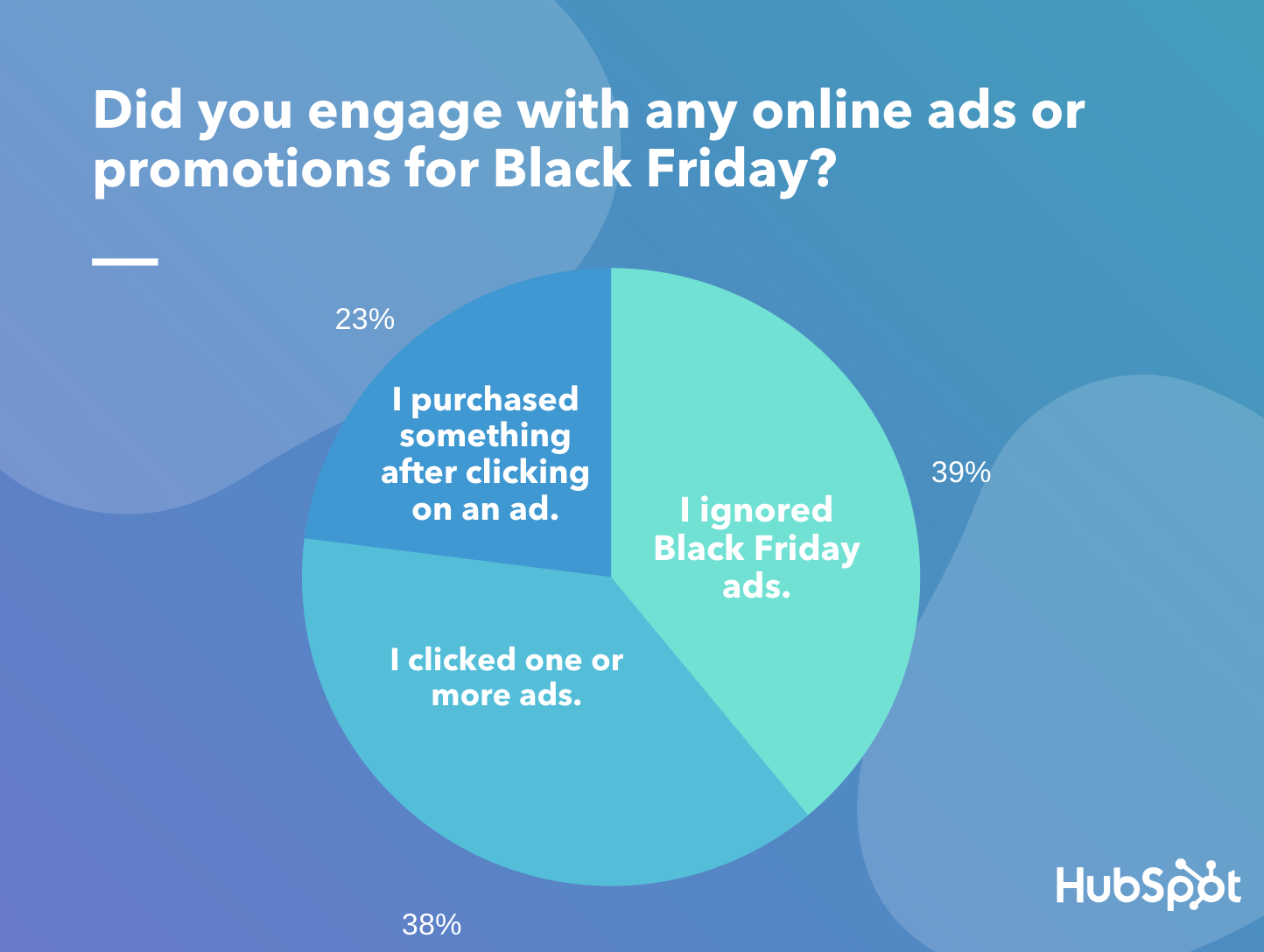
Data Source: Lucid Software
Of that 61% of people who engaged with one or more ads, 38% clicked on the promotions without making a purchase, while 23% converted to a customer after clicking the ad.
When it comes to where people saw the ads they clicked on, 62% found promotions on social media.
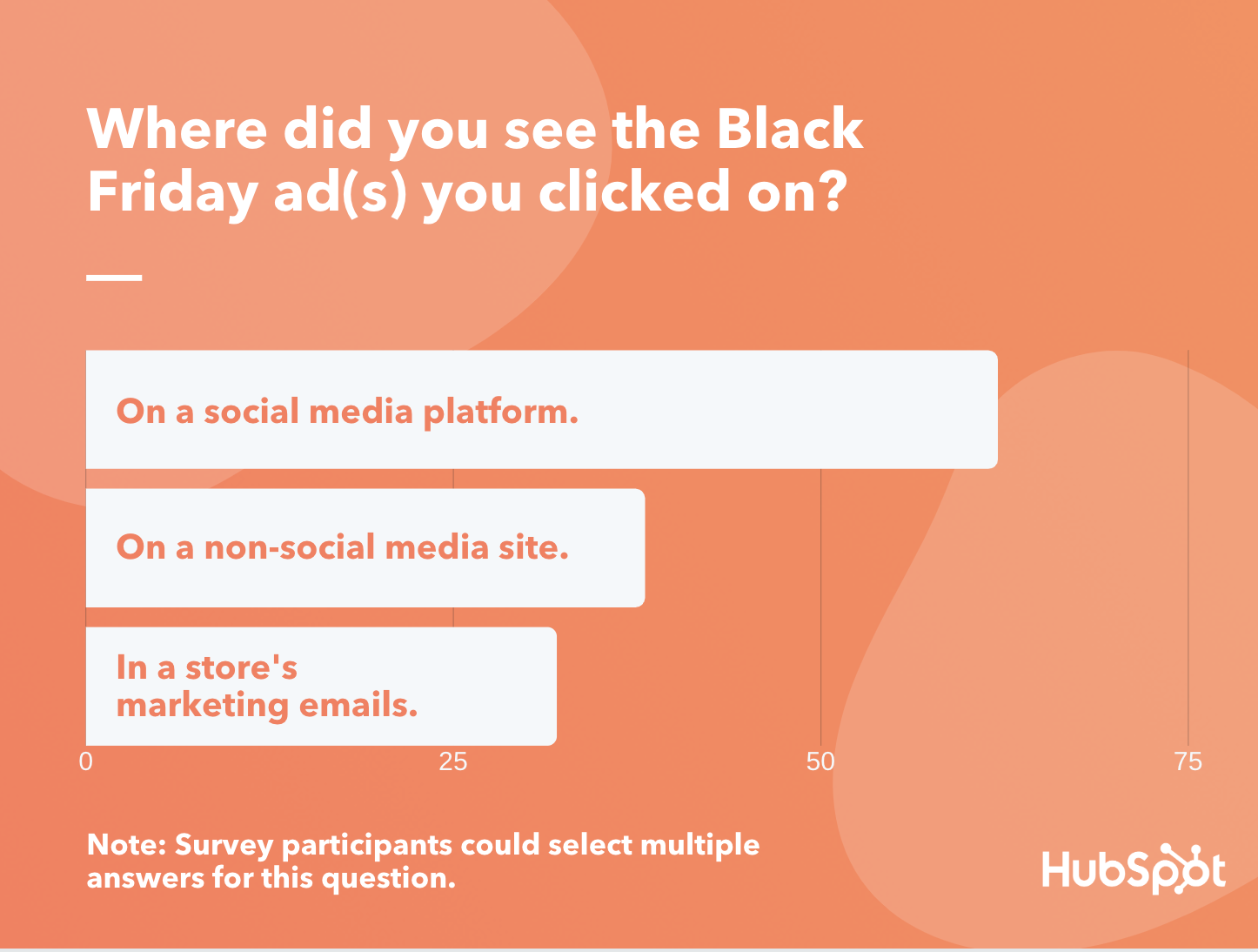
Data Source: Lucid Software
"Non-social media sites" were also a fairly successful place for promotion, with 38% of people saying they clicked on ads in these locations. These sites could include websites owned by other brands where a native ad is located, search engine platforms, or other areas of the web that aren't considered social media.
Although only 32% of people said they clicked on ads shown in marketing emails, recent research still shows that this tactic is still a vital part of digital marketing. In fact, CampaignMonitor recently published research showing that email marketing was responsible for 20% of holiday-related traffic.
Aside from the ad's location, the product or service advertised could have played a role in an audience's level of engagement. To get an idea of which products were most popular, I asked survey participants, "Which best describes the products or services that were featured in the Black Friday ads you clicked on."
Of those who said they clicked on or purchased something from an ad in the first question of the survey, roughly 36% said the ads they engaged with featured products in the "Gadgets and Technology" category. Meanwhile, two other popular categories were "Fashion and Beauty" and "Home Goods, Furniture, and Decor" which both received votes from more than 18% of participants.
Black Friday Ads Actually Lead to Foot Traffic
In 2019, in-store Black Friday foot traffic dropped 6% lower than in 2018. However, this shopping event was still significant for brick-and-mortar stores as earnings from in-store purchases still rose by 4.2%.
Much of the in-store foot traffic and purchases could have also been because of ads. When I asked consumers if they "entered a store on Black Friday after seeing an ad or promotion for its sales," more than half said, "Yes."
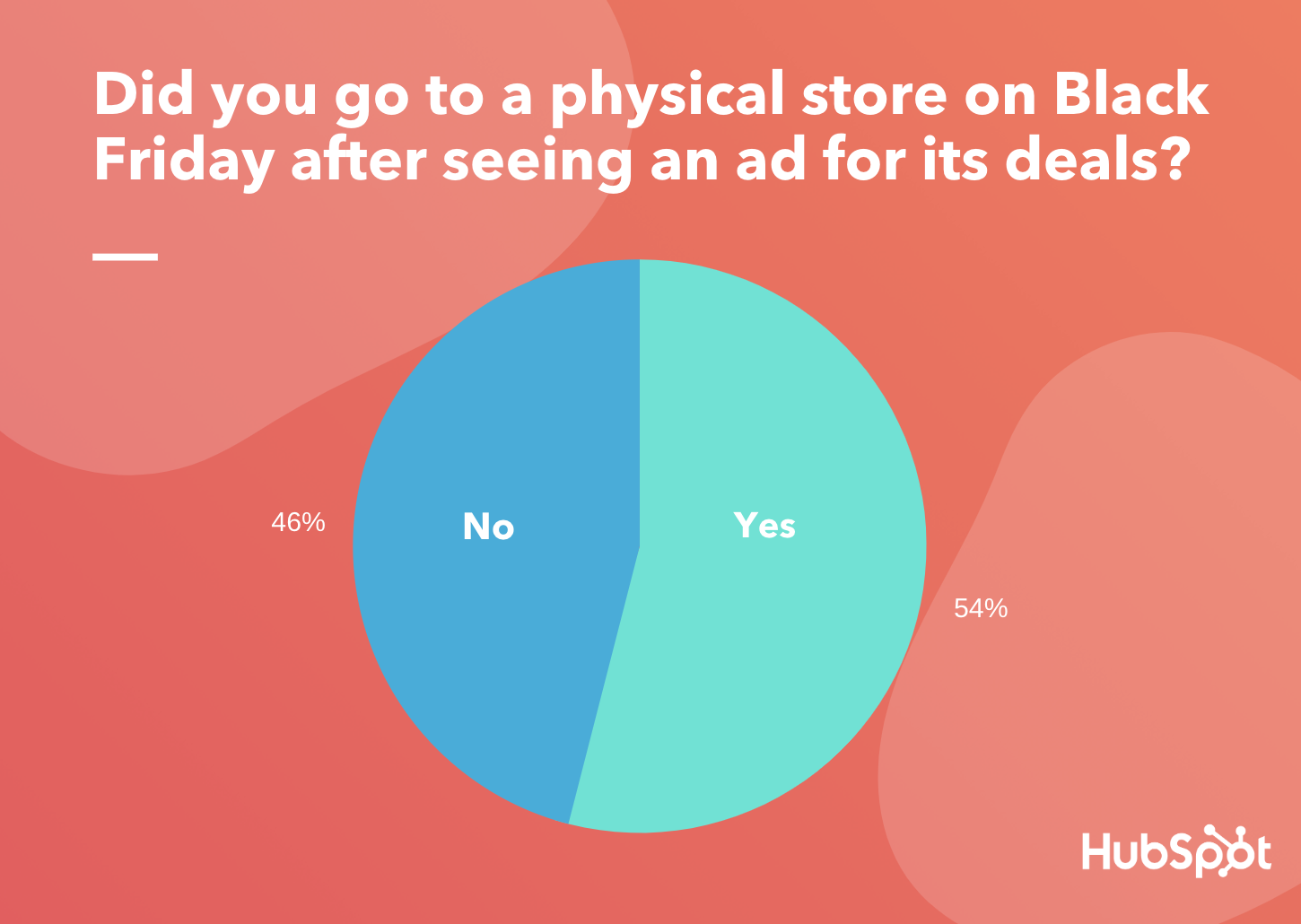
Data Source: Lucid Software
To determine how much impact online ads made on Black Friday foot traffic as compared to physical ads, I asked the same consumers, "Where did you see the Black Friday ads for the store you visited on Black Friday?" Those surveyed could choose from a long list of ad style options from more digital social media promotions to traditional TV commercials or newspaper advertisements.
Although these participants decided to brave crowded physical stores on Black Friday, the survey found that they weren't pulled into them by physical or more traditional ads like billboards, newspaper promotions, or commercials.
Again, social media was the front-runner, as 38% of people who entered stores on Black Friday found ads on these types of platforms first.
Aside from social media, 15% of those who visited a store due to a Black Friday ad said they saw it on the store's own website. Only small portions of those surveyed said they went to a store after seeing television commercials (7%), email marketing ads (7%), newspaper promotions (8%), or physical signage (1%).
Although only 7% found ads that led them to physical stores in marketing emails, other data shows that including ads and offers in e-newsletters was still a vital strategy for gaining web visits, leads, and even in-store foot traffic.
4 Predictions for Black Friday 2020
When we last published this post in December 2019, we anticipated that web presence and online marketing would be key for small and large businesses in 2020.
Now that the COVID-19 pandemic has brought many brands online -- and quickened digital transformation around the globe -- an internet presence isn't just nice to have. At this point, it might be vital.
Below are just four research-backed Black Friday predictions and tips for how brands can navigate themy.
1. Brands with an online presence will outperform brands without one on Black Friday.
Our 2019 results and mounting research continues to show the growing importance of developing or constantly improving on a web presence.
And as we mentioned, an online web presence might not just be a nice perk for your customers. It might result in ROI for your brand, especially on Black Friday. In 2020, it's projected that online holiday spend will surpass $189 billion — up 33% from 2019.
At this point, growing an online presence can be easy and affordable. For example, if you're just tipping your toes into online marketing, you could start with free strategies like building a social media profile, launching a basic website, starting a marketing email, or creating a Google My Business for your store. Then, once you're comfortable, you experiment with larger investments such as buying online ads.
The strategies above will allow people across the web to learn more about your brand, offerings, or services. These tactics could also make it easier for prospects to find you when they're researching products or services in your industry.
2. Consumers will continue to use social media to learn about products and Black Friday sales.
While an overall internet presence could take your brand a long way, a great and affordable place to start marketing or advertising could be on social media platforms like Facebook or Instagram.
Due to social media's popularity and track record for ROI, you'll definitely want to consider advertising or at least posting for free about your products on platforms that align well with your audience if you aren't doing so already.
If you're trying to build your social presence, or determine which platforms you should be promoting your products or deals on, check out this research-based blog post where I reveal which social media platforms people use to learn about products.
3. Most Black Friday purchases will happen online.
This might sound like a no brainer, but it is important to keep in mind as you plan your Black Friday strategy for 2020.
While there will still likely be Black Friday shoppers that brave crowded stores, the 2019 and 2020 data above suggests that more people will avoid in-person shopping as much as possible on Black Friday -- as well as throughout the holiday season.
This year, people have embraced online shopping and ecommerce more than ever before. And, even if a physical store hosts a big sale, consumers might be more likely to order products from the safety of their own home.
Along with online advertising and marketing techniques, you'll also want to consider other ways that your brand can do business online. For example, it might be an excellent time to launch an online store or virtual services ahead of the global shopping holiday.
If you don't consider yourself web savvy, a number of tools and platforms can help you create and manage an online store in minutes. For example, Facebook recently launched Facebook Shops, which allows users to create online stores linked to directly to a Facebook or Instagram Business profile.
4. People will place needs over perks when purchasing products.
This year, we've seen consumers toss aside fancy products and brand loyalty to budget for products that help them solve problems or provide long-term value.
Why? Due to the financial uncertainties of 2020, consumers are finding themselves on tighter budgets and are more cautious than ever about bigger investments.
What does this mean for marketers? It will be more important to market your product, deal, or sales value points than ever before. Even if you work for a notable brand, consumers will be looking for value beyond your logo in order to justify buying something. In the section below, we'll give you a few tips on how to do just that.
Tips for Creating Effective Black Friday Ads
1. Highlight how a service or product can solve for your customer.
Remember, this year, shoppers of all ages will be more cautious than ever about the products they'll be buying. While some might be saving up to splurge during the holiday season, they'll still be taking their product research seriously to determine that anything they spend money on will have solid value.
For marketers and advertisers, this means that your ads should aim to educate ideal customers about your offerings, how they can help them, or why they might need them in their daily lives.
But, how do you convey that your offerings are valuable, important, or necessities when you don't actually sell an essential product? Although it can take some creativity, it is possible to do this.
Below is an example of Twitter content from InfoArmor, an information security service owned by Allstate. In the tweet, InfoArmor shared a blog post about the dangers of information security when working remotely and how InfoArmor could protect remote employee information.
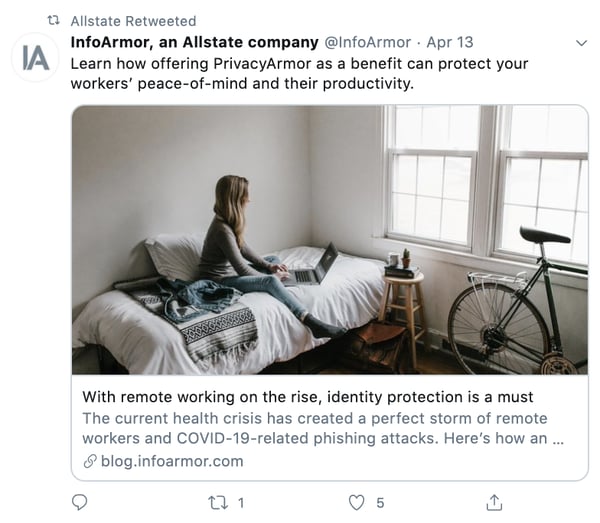
2. Present deals, sales, or affordable offers.
Aside from aiming to buy products with the best value, budget conscious shoppers will also be looking for the best deals this holiday season. If you can offer a deal or sale on your product or offering, embrace that information in your advertising. Here's a great ad from Walmart that highlights all the online deals they'll be offering this year:
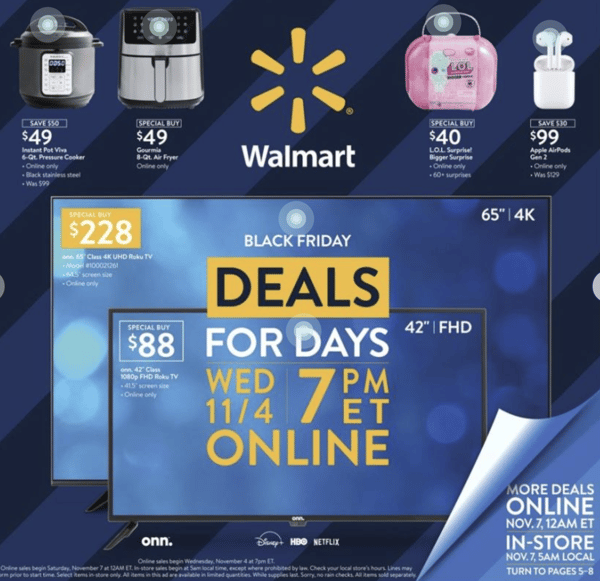
Source
Along with the ad highlighting a bunch of great deals and alternatives for Black Friday in-person sales, the ad is also interesting because it's interactive online but formatted so it can also work as a static print ad if needed.
Aside from the ad above, Walmart has created content with a similar aesthetic and deal-oriented message for social media platforms like Facebook. Here's a screenshot of featured content on its Facebook Business page.
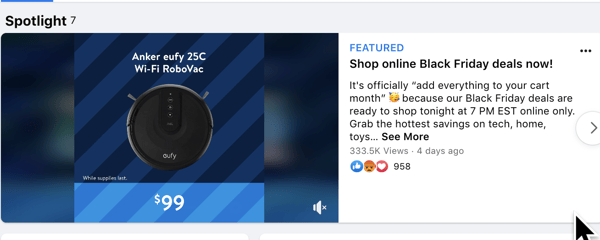
3. Embrace video marketing.
In our 2020 State of Marketing Report, we found that video is the leading form of marketing content used across industries. And, with Gen-Z and millennials embracing video more than ever for product discovery, this format becomes more of a low-hanging fruit each year.
If you think video marketing is only for big brands, think again. In the last year, we've seen all sorts of small and large brands affordably embrace video ad and long-form content strategies that helped them gain ROI. Here's one great example of a startup demo video created by Beauty Bakerie.
While the content allows viewers to see what the products will look like in real life, Cashmere, the brand's CEO -- Cashmere Nicole Carillo -- gives instructions on how to use it so they'll also know just how easy it is to add to their daily beauty routine.
4. Create content for different online platforms.
Regardless of which online platforms you embrace, be sure to create content that speaks to those customers, rather than just placing a basic ad on every website you can access.
By creating content that's tailored to platforms your customers use, you'll increase the likelihood of catching their eyes as they scroll through endless web pages, feeds, or email inboxes. And, once you grab their attention, you can use that content to highlight your value proposition in an entertaining or interesting way.
For example, if you're creating an ad for Instagram, it might be tempting to just use a picture of the ad you made for a website or newspaper on with a basic caption. But, that might not be engaging for people scrolling through their feeds looking for valuable product information or entertaining content. Instead, consider creating a short marketing video or a series of photos of customers with your product to better engage this audience.
Below is a great example of a Black Friday post that could also work well as an ad on Instagram. The post shows a video demo of someone from Hair Vivi putting on one of the brand's wigs.
While the video shows viewers how easy it is to put on the wig, the caption also highlights the product's value and the company's Black Friday deals.
Navigating Black Friday 2020
It's safe to say this year's Black Friday will be one of a kind. But, many of the consumer behaviors you'll see won't go away. anytime soon.
On Black Friday and throughout the rest of 2020, some of the most successful brands will embrace online marketing strategies, meet their audiences on the platforms they regularly use, and effectively leverage content to highlight the value or affordability of their products.
Craving more Black Friday data ahead of the event? Check out this handy list of stats.
Editor's Note: This blog post was originally published in December 2019 but was updated for freshness and comprehensiveness in November 2020.
from Marketing https://ift.tt/39pq4xt

No comments:
Post a Comment